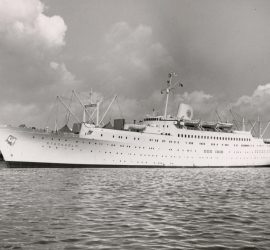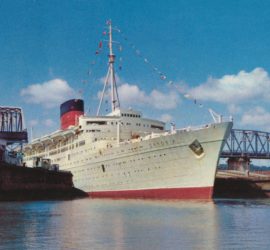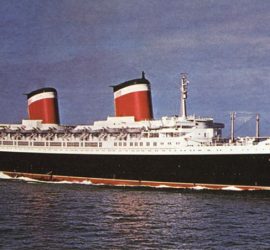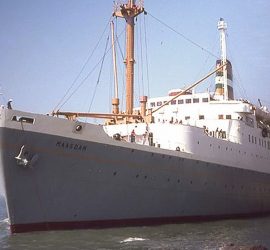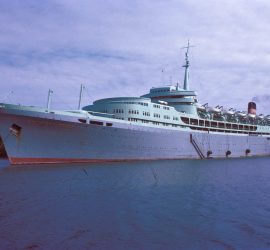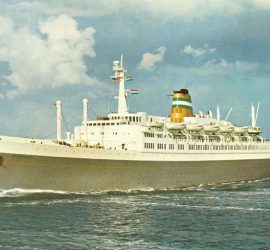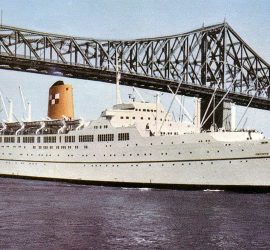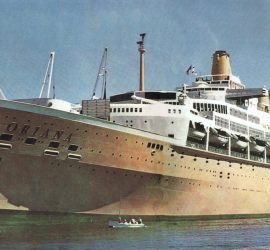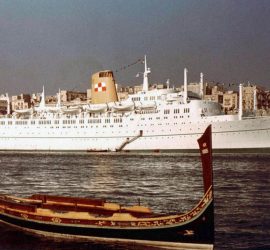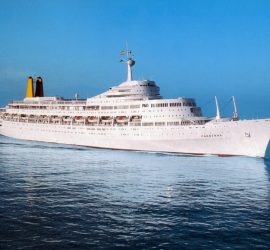1948 – Present Day / Also known as Völkerfreundschaft, Volker, Italia, Italia Prima, Valtur Prima, Caribe, Athena, Azores, and Astoria / A smaller ship of the Swedish-American Line, the Stockholm became famous when she collided with and sank the Andrea Doria in 1956. The ship survived and would have a long career and remarkably, she is still in service today, although heavily rebuilt and virtually unrecognisable.
Henrik Reimertz
1949 – 1974 / Also known as Columbia and Caribia / Purpose-built for leisure voyages, Cunard’s ‘Green Goddess’ Caronia was unique in every sense of the word. Offering an exclusive experience, she was a sign of the times that passenger shipping was transitioning from crossings to cruises.
1952 – Present Day / The ocean greyhound to rule them all, United States was the last liner to capture the Blue Riband. However, her career was soon put on life support with government subsidies, and she was retired in 1969. Astonishingly, she survives to this day, although a sad shadow of her former self and with a very uncertain future.
1952 – 2000 / Also known as Stefan Batory and Stefan / As part of the new tonnage that was added to the Dutch merchant fleet after World War II, the fourth Maasdam brought many innovations with her design. She would go on to enjoy a career of almost half a century, before being sold to Turkish shipbreakers.
1955 – 2003 / Also known as Calypso, Calypso I, Azure Seas, and OceanBreeze / Breaking the mould with an innovative exterior design, the long career of the Southern Cross would see her go from being daring and new to representing the old guard among modern cruise ships. Remarkably, she survived into the 21st century, but was ultimately sent to the breakers.
1957 – 2004 / Also known as Rhapsody and Regent Star / One of the larger and faster additions to the Holland-America Line’s fleet in the post-war years, the fourth Statendam remained with the company into the eighties. Her career continued with other companies, and she managed to survive into the 21st century before finally being sold for scrap.
1957 – 1975 / Also known as Ocean Monarch / Another post-war ship that was built when the economy had recuperated, the Empress of England helped modernise the Canadian-Pacific fleet. Later in life, she was sold and refitted as a dedicated cruise ship, but lasted only a few more years before she was sold for demolition.
1960 – 2005 / A ship with a singular look, the Oriana’s exterior design stood out among her contemporaries. She was the largest ship of her time operating the Australian run, and she served profitably until 1986. She then spent some 20 years as a floating venue at various Asian ports, before being sold for scrap in 2005.
1961 – 2003 / Also known as Mardi Gras, Star of Texas, Lucky Star, and Apollon / Part of the revitalisation of the Canadian-Pacific fleet, the third Empress of Canada is arguably best remembered for becoming the first ship of the Carnival cruise fleet as the Mardi Gras.
1961 – 1997 / The ‘Great White Whale’ of the P&O Line, Canberra was one of the last great liners built in the British Isles. Serving in the Falklands War, she had a long and prosperous career that eventually ended at the shipbreakers.

